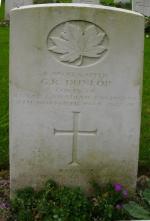George Russell Dunlop was born in Meaford, Ontario. He enlisted on 8 July 1940 in Victoria, British Columbia and was assigned to the 4th Field Park Squadron in North Vancouver, BC. He was an acetylene welder and mechanic at the time, working in Parksville, BC. His wife of 15 years was living in Semans, Saskatchewan at the time with their two daughters and son.
George was recalled from Christmas leave in January 1941 and sent to Camp Petawawa when the 4th Field Park Company was redesignated as the 4th Field Park Troop and shortly after, the 4th Field Park Squadron. By the end of that year, when the squadron arrived in the United Kingdom, he was drawing pay as a Welder Group ‘B’, was qualified in demolitions, and was a driver Class I. In October 1943, he was posted to the Engineer Reinforcement Unit (ERU) and a few weeks later to the 6th Field Park Squadron who spent the next eight months training for the upcoming landings in Europe.
The Squadron landed in France on 26 July 1944 using the artificial harbour at Arromanches. With the rest of the 4th Armoured Divisional Engineers, they set out working in the area of Caen mostly clearing rubble and opening routes under almost constant German artillery fire. In early August, they took part in Operation TOTALIZE, one of the last battles in Operation OVERLORD and the first for the newly formed 1st Canadian Army. As the Division moved forward out of France and into the Low Countries, the Squadron supported the crossing of the Seine and the clearing of the Channel Ports. In September, they supported the initial attempts to establish crossings of the Leopold Canal and were thrown into the Battle of the Scheldt through October and November, first in support of the 3rd Canadian Division assault into the Breskens Pocket and later along the right flank as the 2nd Canadian Division through the Beveland fight and onto to the German border.
On 5 November 1944, the town of Steenbergen was liberated and the Squadron moved in to set up. After getting troops settled in and setting up a spartan HQ in a bombed-out grain storage building, attention was turned to rest and maintenance. The biggest worry was water supply. Ironically, in a land of canals and rain, dykes damaged from RAF bombing left most available supplies salty. Although other troops were given opportunities for rest and relaxation as the Scheldt battle drew to a close, there would no opportunity for the sappers to take any leave out of the front lines for another two weeks.
On the night of 6 November, Sapper Dunlop was returning from an authorized recreational run into town on the back of a motorcycle driven by his friend, Sapper Carter. Along the way, Carper pulled over to the side of the road to allow an oncoming jeep to pass when Dunlop slipped off the bike. He was knocked unconscious and Carter called an ambulance. The ambulance attendant assessed that Sapper Dunlop was simply drunk and took him back to the squadron’s billet area. When Sapper Carter got back, he and a mate had started to undress Sapper Dunlop and put him to bed when they saw blood coming from his ears. They took him into the hospital in Bergen-Op-Zoom where he later died of a brain hemorrhage. He is buried in the Schoonselhof Cemetery near Antwerp. He was 41 years old.
At the time of his death, George had two younger brothers also serving overseas, one in Northwest Europe and in Italy.
Return to Part 5: Tributes to the Fallen Sappers of the Scheldt

